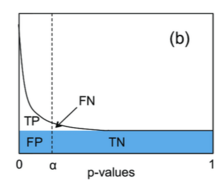In statistical hypothesis testing, specifically multiple hypothesis testing, the q-value in the Storey procedure provides a means to control the positive false discovery rate (pFDR).[1] Just as the p-value gives the expected false positive rate obtained by rejecting the null hypothesis for any result with an equal or smaller p-value, the q-value gives the expected pFDR obtained by rejecting the null hypothesis for any result with an equal or smaller q-value.[2]

- ^ Storey, John D. (2002). "A direct approach to false discovery rates". Journal of the Royal Statistical Society, Series B (Statistical Methodology). 64 (3): 479–498. CiteSeerX 10.1.1.320.7131. doi:10.1111/1467-9868.00346.
- ^ Storey, John D. (2003). "The positive false discovery rate: a Bayesian interpretation and the q-value". The Annals of Statistics. 31 (6): 2013–2035. doi:10.1214/aos/1074290335.